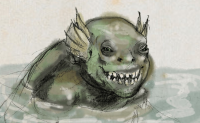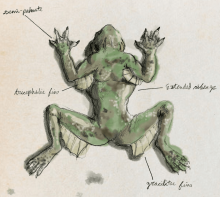Maerrow
| Maerrow | |
|---|---|
 | |
| Fauna | |
| Official Name | Maerrow |
| Common Nicknames | Water Gremlin, Swamp Goblin |
| Classification | Reptile |
| Habitat | Essalonia |
| Domesticated | No |
| Current Status | Rare |
The Maerrow are small fish-people that hail from Essalonia. These carnivorous beings are known to steal the bounty of fishermen on the ocean and in rivers for themselves while also hunting down singular or small groups of targets. They are also known for their hideous, tooth-filled grins which they maintain throughout their lives. Figures of malice to the local Velheim, they will most likely go extinct in the coming years if they maintain their low population density, largely centered on the central waterways of Veløya in western Essalonia.
History
The Maerrow share a similar history of discovery to the Kelp, the other major aquatic predator in western Essalonia. After the arrival of the Proto-Velheim sometime around 300 BC, the Maerrow were seen as mythological creatures, but unlike the Kelp, they had the sheer numbers to quickly show the truth of their existence. There are some tales of more intelligent Maerrow, however, who could speak and that early relations with the Velheim were peaceful. As the Proto-Velheim were militarized, these relations, if they ever existed, broke down, and with both these local conflicts and the destruction of the Cataclysm, the Maerrow were forced back. Their numbers dropped rapidly, and they soon settled to live only in the deep swamps of Veløya, where they had originated from centuries ago. Some scant groups have held out elsewhere, a few being known to inhabit the southern sinkholes alongside groups of Kelp, but overall they now remained trapped to the central, wild regions of the continent. Unlike the Kelp, their common numbers until this point proved their existence to many, though doubts about their possible intelligence, and ancient past, remain strong. Luckily in the eyes of most locals, the Bone Horror Crisis seems to have hit the species hard, but much like the Kelp, the Maerrow are creatures quite capable at hiding and none have chosen to go and check if their lack of presence truly indicates another fall in their numbers, or they have mere slipped under the waters, waiting to pounce out at their prey.
Physical Appearance
The Maerrow are smaller than Dwarves, standing between three and a half to three and three-quarters feet tall with a weight of 40 to 45 pounds. Their head is their most distinguished feature, and it is the part of their bodies most commonly seen. It possesses anywhere from one to three pairs of head-fans resting behind or around their “earhole”, sometimes with a set of head-fans protecting the organ. Their heads are bald and smooth, lacking any ridges, and are only punctuated by the aforementioned fans, alongside two small, squinting, green-tinted eyes, and their large mouths. Inside of their mouths sit rows of jagged, sharp teeth, which are often on display as the Maerrow lacks lips. This leads them to appear to be constantly, evilly grinning. As for the rest of the body, it is formed to slip through the water with ease, an additional set of fans sitting on their arms and thighs to help them steer in the water. Their spine slowly warps with age and they grow more hunched over time. They are aided in aquatic activities by a set of huge lungs, as while they are more reptilian than fish, they need air but can stay submerged for up to twelve hours. Their hands are small and four-fingered but possess sharp claws which they use to cut through fishing nets and attack larger prey. Their skin meanwhile is made up of smooth scales and their entire body is covered in murky brown and dark green splotches in a random pattern. In the sunlight, these colors lighten and the species is overall believed to have a weak camouflage ability.
Diversity
Maerrow have very little difference between the two genders as females do not possess mammalian gender indicators though males range on the higher end of the height spectrum than females. Their age is also determinable by their head-fans, one to five years having one fan, five to ten years two fans and any age past that having three. Their gender birth ratios are equal in number.
Life Span and Development
Maerrow are born in clusters of eggs each an inch wide in diameter, which adhere together and float on the surface. They hide themselves on or inside aquatic plant life and plant growth from the land into the water such as tree roots or rotting logs. After a period of three months, the young Maerrow emerge and swim downward where their pack greets them if they are still alive. The young Maerrow are then taught all they need to know over the next nine months. By one year of age, they reach their full size and are able to reproduce though most wait for at least another six months. They have a maximum lifespan of fifteen years.
Mental Overview
Maerrow are wild animals and are hostile to outsiders and sentient Races. They do, however, get along well with the Kelp whom they sometimes share waterways with. Some outsiders even consider them partners, though this is not wholly true as the most co-operation the two species possess is that one will sometimes allow the other to feed off of their scraps. Beyond this, they are known for being tricky, stealing nets of fish for themselves and avoiding traps laid by hunters to catch them. Among their own kind, they are generally caring as the older and more proficient Maerrow leave to hunt and provide for the others. In the hunt, they prefer to wound prey and to attack prey that is isolated. They then follow their victim slowly, heads poking out of the water as they do so, slowly revealing more of their grin as the subject dies, an overall horrific end to any caught in their dark trap.
Territory and Groupings
Maerrow once existed in large communities, however, with humans hunting and exterminating them, they have since retreated into more reclusive and smaller communities. These groups are hostile to the Alorian Races that harm them and function in a hierarchy of larger males acting as the hunters for the dens, bringing food and other necessities back home to the others. Such groups number anywhere from ten to twenty and are most commonly found in swampy waters. They are not territorial to others of their own kind though they resist such groupings to ensure their survival.
Trivia
- Maerrow are largely unfit for the consumption of most Races. Not only do they have a general lack of substantial meat, but their constant exposure to stagnant and dirty swamp water has caused their flesh to become foul. The few brave or foolish enough to consume Maerrow meat have come down with food poisoning.
- Maerrow were once assumed to be the male partners of the Kelp, and still appear as such on the majority of regional Velheim art.
- Maerrow sometimes use their claws and teeth to mark docks or water-based structures of settlements if they are too close to their territory.
| Accreditation | |||||||||
|---|---|---|---|---|---|---|---|---|---|
|
| ||||||||
